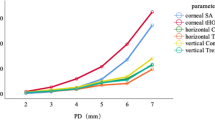Abstract
Background
To evaluate accuracy of WASCA wavefront aberrometry (WA) refraction in comparison to manifest refraction (MR) in an older population awaiting cataract surgery.
Methods
Prospectively, refractive errors of 130 eyes were determined by WA and MR. Mean age was 65.9 (SD 11.81), corrected distance visual acuity (CDVA) averaged 0.20 logMar (SD 0.57), mean manifest sphere was 0.23 dioptres (D, SD 3.39) and manifest astigmatism amounted to −1.25 D (SD 1.21). For further analysis, refractive values were transformed into power vector components: spherical equivalent (SE), Jackson cross cylinder at 0° and 45° (J0 and J45). The ‘limits of agreement’ approach, regression analysis, correlation analysis, and ANOVA were applied and additionally compared to 28 healthy eyes (mean VA −0.1 logMAR) of a group of young subjects (mean age 33.9).
Results
SE measures in myopia correlated highly between WA and MR (r = 0.917, p < .001). In hyperopia this correlation was moderately high (r = 0.800, p < .001). For all subjects, correlations between WA and MR for J0 and J45 were r = 0.742 (p < .001) and r = 0.760 (p < .001) respectively. WA measurements revealed larger agreement ranges with increasing myopia and astigmatism. Controlled for possible confounding variables of age, VA, and refractive state, no statistically significant effects were found. Across nearly all conditions, WA measured significantly higher myopic and astigmatic values than MR. Most effects were replicated in the reference group.
Conclusions
WA refraction can provide valuable information in previously under-researched conditions such as reduced VA (cataract-related), advanced age, and hyperopia. However, loss of optical media transparency will inherently reduce accuracy of WA. Further studies are needed to define cut-off values for automated wavefront quality grading and intra-operative application of WA in refractive surgery.




Similar content being viewed by others
References
Lombardo M, Lombardo G (2009) New methods and techniques for sensing the wave aberrations of human eyes. Clin Exp Optom 92:176–186
Buehren J, Kohnen T (2007) Application of wavefront analysis in clinical and scientific settings. From irregular astigmatism to aberrations of a higher order —Part I: Basic principles. Ophthalmologe 104:909–923
Cervino A, Hosking SL, Rai GK, Naroo SA, Gilmartin B (2006) Wavefront analyzers induce instrument myopia. J Refract Surg 22:795–803
Reinstein DZ, Archer TJ, Couch D (2006) Accuracy of the WASCA aberrometer refraction compared to manifest refraction in myopia. J Refract Surg 22:268–274
Rozema JJ, Van Dyck DE, Tassignon MJ (2006) Clinical comparison of 6 aberrometers. Part 2: statistical comparison in a test group. J Cataract Refract Surg 32:33–44
Taneri S, Oehler S, Azar DT (2011) Influence of mydriatic eye drops on wavefront sensing with the Zywave aberrometer. J Refract Surg 27:678–685
Zhu X, Dai J, Chu RLY, Zhou X, Wang L (2009) Accuracy of WASCA aberrometer refraction compared to manifest refraction in Chinese adult myopes. J Refract Surg 25:1026–1033
Thibos LN, Horner D (2001) Power vector analysis of the optical outcome of refractive surgery. J Cataract Refract Surg 27:80–85
Altman DG, Bland JM (1983) Measurement in medicine: the analysis of method comparison studies. Statistician 32:307–317
McAlinden C, Khadka J, Pesudovs K (2011) Statistical methods for conducting agreement (comparison of clinical tests) and precision (repeatability or reproducibility) studies in optometry and ophthalmology. Ophthalmic Physiol Opt 31:330–338
Mirshahi A, Bühren J, Gerhardt D, Kohnen T (2003) In vivo and in vitro repeatability of Hartmann–Shack aberrometry. J Cataract Refract Surg 29:2295–2301
Duane A (1912) Normal values of the accommodation at all ages. JAMA 59:1010–1012
Artal P, Berrio E, Guirao A, Piers P (2002) Contribution of the cornea and internal surfaces to the change of ocular aberrations with age. J Opt Soc Am A Opt Image Sci Vis 19:137–143
McLellan JS, Marcos S, Burns SA (2001) Age-related changes in monochromatic wave aberrations of the human eye. Invest Ophthalmol Vis Sci 42:1390–1395
Fujikado T, Kuroda T, Maeda N, Ninomiya S, Goto H, Tano Y, Oshika T, Hirohara Y, Mihashi T (2004) Light scattering and optical aberrations as objective parameters to predict visual deterioration in eyes with cataracts. J Cataract Refract Surg 30:1198–1208
Applegate RA, Donnelly WJ 3rd, Marsack JD, Koenig DE, Pesudovs K (2007) Three-dimensional relationship between high-order root-mean-square wavefront error, pupil diameter, and aging. J Opt Soc Am A Opt Image Sci Vis 24:578–587
MacKenzie GE (2008) Reproducibility of sphero-cylindrical prescriptions. Ophthalmic Physiol Opt 28:143–150
Pesudovs K, Parker KE, Cheng H, Applegate RA (2007) The precision of wavefront refraction compared to subjective refraction and autorefraction. Optom Vis Sci 84:387–392
Stringham J, Pettey J, Olson JO (2012) Evaluation of variables affecting intraoperative aberrometry. J Cataract Refract Surg 38:470–474
Packer M (2010) Effect of intraoperative aberrometry on the rate of postoperative enhancement: retrospective study. J Cataract Refract Surg 36:747–755
Author information
Authors and Affiliations
Corresponding authors
Additional information
Jan O. Huelle and Toam Katz contributed equally
Notes
The authors have full control of all primary data, and agree to allow Graefe’s Archive for Clinical and Experimental Ophthalmology to review the data upon request. Financial relationships with the organisations that provided the instruments used in this study do not exist. The authors have no proprietary or commercial interests in any material or methods discussed in this paper. The authors do not report any conflict of interest or opinion. No financial support was received for this study. Parts of this study were presented at the 110. DOG Congress, 20–23 September 2012, Berlin.
Rights and permissions
About this article
Cite this article
Huelle, J.O., Katz, T., Draeger, J. et al. Accuracy of wavefront aberrometer refraction vs manifest refraction in cataract patients: impact of age, ametropia and visual function. Graefes Arch Clin Exp Ophthalmol 251, 1163–1173 (2013). https://doi.org/10.1007/s00417-012-2246-7
Received:
Revised:
Accepted:
Published:
Issue Date:
DOI: https://doi.org/10.1007/s00417-012-2246-7




